A Hidden Process
part two
| A special place has to built to conduct the transformational process. At MG Taylor we call these navCenters. Although they can be used for many tasks, navCenters are designed to augment and facilitate human and organizational transformation. There are many aspects to this: A transformational process requires a great many collaborative design and learning events - of a wide variety of kinds - which are not well supported by conventional work environments. These activities have to be continuous and therefore cannot be supported only by remote, retreat meeting places. The main environment of the transformational process has to be neutral territory not associated with any part of the enterprise in an organizational or political sense. It has to be the symbol of the future to-be-transformed organization - not its past. The organization’s legacy should and can be incorporated into this architectural aspiration which is a cathedral to the spirit of the new organization and its people. |
| If you want to transform an organization and its people, put them into the best facsimile of the new organization which you can imagine and invite them to do the work of the organization in this environment of physical place, knowledge augmentation tools and work processes. This work must include planning the organization’s future. Also, it also requires they study the means by which they can become competent to function in that future organization and the world which requires it. It is important to understand that the work processes, embedded in the NavCenter environment, include protocols which largely replace many of those which, today, are considered essential management activities that have been separated from the work process and imposed upon it. |
| This environment, therefore is a place for a new kind of work and learning, a neutral habitat with no ax to grind, a means to design a future while in it, a symbol of this future and an R&D lab where new work protocols can be discovered, tested and proven valuable before they are scaled throughout the larger body of the enterprise. The transformational experience is made physical,tangible and real. |
| There are two aspects, beyond the myriad of work functions it must support, which the architecture of the NavCenter must directly express. These are what, in the Taylor Method, are called the habits of creative people and strong memory. It is these, along with the product of their work, which people take out of the NavCenter and back into the many existing places of the organization which are still running the “old” way. These habits - and the memory of transforming experiences - has to be strong enough to survive and ultimately prevail in this environment, which by definition, is the embodiment of another structure. Another structure, by the way, that once was radical and transformational itself. |
| In time, the environment of the NavCenter becomes distributed throughout the organization. Its principles survive but its literal from is made specific to the new organization which emerges out of it. This is an important two step process essential to all transformational efforts: some notion and tool of the new organization is required to facilitate the process. What emerges will be different. Then, this tool-of-transformation is recreated and becomes the means of all work and ongoing recreation of the organization. |
the_cognitive_environment |
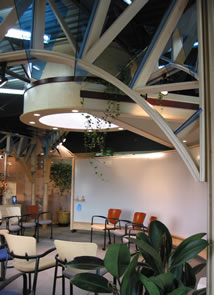 |
Light, air, growing plants and vista are as important in the interior environment as the outside landscape. In today’s cities perhaps even more so. The direction that the eye moves and a person’s reaction to prospect and refuge, architectural order and ambiguity, has cognitive implications.
Colors, textures, shapes and forms, as well as the rhythm sequences between them, have connotative meaning.
These plus iconic objects make architecture a four dimensional tablet full of meaning and embedded instructions.
The space of an environment and its connotative elements sum up to a sense of place and an objective statement of philosophy. Architecture is built philosophy.
How an environment is built is a sermon in stone about design and collaborative processes, supply chain management, integrity of purpose and the builder’s view of the quality of human life. It shows, directly, what matters to those who build.
Architecture expresses human aspiration and exercises a, too often not recognized, profound effect on human consciousness. This is true, and important, in all of the built environment but economically critical to the workplace where it is least understood. To those places devoted to learning, design, strategy and transformation, the quality of the environment is not a nice-to-have - it is essential. |
|
 |
 |
 |
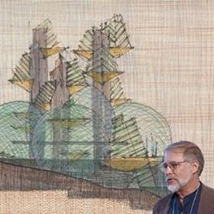 |
| In order to embed the creative habits [link: creative habits] and to create strong memory [link: strong memory], there are certain principles that environments designed to support a transforming process have to practice and design elements which they must possess. This is the exercise of biomimicry in the design process both in creating the design and operating the environment after it is built. As example, the human brain employs distributive architecture in its memory system. If you want mind-like characteristics in your environment, distribute a high variety of memory agents throughout your environment and weave them into your collaborative design processes. When this is done at scale and to critical mass, the environment takes on an entirely different aspect in regards this (only one of many important qualities) important attribute. It is this method which Wright meant when he used the term “organic architecture.” He did not just mean using wood and lots of plants. It was the process of learning from Nature and actively building natural aspects into the building that he was addressing. This is why his works seem so magical to this day 50 to a 100 years after they were built [link: guggenheim_50_year_exehibition]. |
|
| For
the TRANSITION MANAGER, getting
entangled in the process is the single
largest risk of Transition Management. Staying
free of entanglement is not an easy thing to do.
These are usually complexities that emanate from
whatever business arrangements are in place. The
Transition Manager may be working as an employee,
a contractor
or even for free - no matter; there are terms of
engagement in place, explicit or implied. It is
by attacking the relationship between the Transition
manager and the organization being transformed,
that resistance to change is
usually expressed. |
| For management, as we think of it in the conventional sense, a great risk is to waver and not follow through. This is almost certainly a disaster in the happening. Equally risky is to depend on outside people to do the job - it is simply not possible to transform this way. Resources can be provided, yes, but the action must be self directed. The greatest risk, however, is in not realizing that transformation means management changing as much if not more than everyone else. To a successful manager, in a well established enterprise, a transformational process is very likely to be seen as a threat to his/her power, position, authority and privilege. And, this is likely true. That there is a better rainbow on the other side of the change is not always clear. The temptation of those with power will be to exempt themselves from the consequences of the change. Transformation is good but not in my back office. |
link
for reverences and examples |
|
| Transformation
within a large organization - or a smaller one within a large system - is always a creature
of critical mass. Critical mass does
not mean the majority - far from it. What constitutes
critical mass, in one situation or another, will
vary. It is usually between 5 to 10 percent of
the total organization. While not an impossible
number, in most circumstances this is a large number. Critical mass is not only a matter of numbers, alone. Who these people are, what and who they represent and where they are placed, within the organization, is also important. These numbers have to be adequately distributed throughout the ValueWeb which is both within the enterprise being transformed and which also makes up the environment within which this organization operates. |
link
for reverences and examples |
|
| The
law of Requisite Variety is the technical
issue that the Transition Manager has to understand. Failure to
do so will lead to the collapse of the
effort.The concept of requisite variety was developed in the early days of cybernetics by Weiner, Ashby and Beer. The concept is simple: a low variety system will be overwhelmed by a high variety system. There is no exception. The variety of a system can only be attenuated or augmented. When transforming a system which is part of a larger system, practical requite variety has to be accomplished. This means the greater system has to be “attenuated” and the lessor system “augmented.” This is accomplished by what is brought into the system-of-focus which is the transformational exercise. What is selected to be “in” or “out” is critical. Things cannot be left out merely to scale the problem to what seems to be a workable level. All the “voices” that represent the elements of the system have to be spoken. True redundancy can be eliminated. There are ways to augment necessary elements. The location, within the system in focus of these voices is significant; how they are “wired” to one another is significant; the process rules that determine their interaction is significant. These are design issues. They determine how the game is set up and the initial conditions of the exercise. This is the PatchWorks Architecture of the venture. This work is as much engineering as is the determination of the structural elements of an aircraft wing. The process by which these networks of critical mass are usually “built” in organizations today is inadequate as is the architecture of the support system and environment intended to facilitate their transformation [link: seven domains model] . |
| Most transformational efforts are soon reduced to mere organizational change. Gail Taylor calls this “reorganizing the deck chairs on the Titanic. The deck looks nice and orderly yet it is going under water nevertheless. Inadequate change processes, lacking appropriate facilitation, critical mass, requisite variety, and sustained effort will simply fade, collapse and usually generate a well spring of unintended consequences. People and enterprises are enormously complex systems. A system cannot be properly transformed by just messing with the parts. To transform successfully, without doing more harm than good, you have to act on the system as a system. To do do, you must focus and bring to bear the same variety as the system. This is what requisite variety means. There are many different kinds of variety. Mass, number of nodes, kinds of nodes, rates of change, tempo, languages, memes, constraints within and without of the system-in-focus, the general environment of the system and its ways of interaction with it. Aspects of this variety equation can be determined appraised and analyzed yet cannot be completely known, understood and controlled. This is why top down command and control techniques fail in complex situations. |
link
for reverences and examples |
|
| Organizational
Transformation usually takes place at two extreme
ends of the organizationaal spectrum. The most common is that the
organization fails. This can lead to the result
of it “going out of business” or being “reorganized,”
purchased, merged or some such thing. These actions
may - or not - actually deal with the inherit characteristics
that lead to the initial failure. There are many
artificial ways to keep an organization going
long after failure
- these are artificial support system tactics.
The rare exception, is that the organizational
is guided through a systematic process than
results in an intended transformational outcome.
What we are seeing, today, in the almost continuous
rise and fall - in the permanent high frequency
oscillations of companies, political movements
and social
trends - is the
consequence
of mismanagement on the meta level of organization.
This is unnecessarily disruptive and costly.
“Fixing it with what is called “reorganization”
is like beating on your car engine with a
hammer when it is
not running
-
it
might
work
but
in the
long run it is a poor strategy - continual
enterprise maintenance is better. |
link
for reverences and examples |
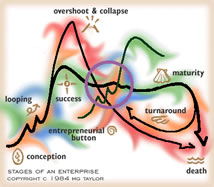 |
| The
Stages of an Enterprise Model is a map of the life cycle of any enterprise be it an idea, a business a country or product. Each of these Stages have entry and exit processes and their unique pattern language. |
|
link
for reverences and examples |
| Today,
we accept this “creative destruction” of
the market place; and, to a certain extent this
is a true
and useful consequence. The old gives way to the
new; failure re-seeds the next cycle of innovation.
We do not, however, separate out the legitimate
recreation cycles from what can only be called
just bad stewardship/management. We do not account
for the loss in national treasure and the disruption
this
causes to individual lives. We do not recognize
what this does to inhibit (because of the, added,
unnecessary risk factor) many new ideas coming
into being. It is
just sloppy management while hiding behind the
skirts of false, exploitive so called capitalistic rhetoric. |
link
for reverences and examples |
| Enterprises,
be they a business, a government, a social movement,
a philosophical idea, a technology do go through
natural cycles of birth, success, decline, death
and sometime rebirth. These cycles can be recognized
and appropriate leadership brought to them - there
are good ways to die as well as bad. The entire
cycle can be managed - not controlled, designed and dynamically managed.
The shift from each of these stages to another
is a transformation - most often, it is not seen
as such and merely “managed” in as business-as-usual
change. An enterprise, often, can get by with
this especially if it is in an ascending market
or a protected one. The accumulation of the oversights
will certainly lead to an unnecessary crises. |
link
for reverences and examples |
| In
this context, it can be understood why I say MANAGEMENT,
today, rarely manage enterprises on the
enterprise level.This can be seen across the
entire spectrum of enterprise types and most particularly
in businesses. Enterprises are directed to
short term results - the regime then
(usually after a great escape with a golden parachute)
leaves the mess to someone else. As the rate of
change
and
complexity
in our world continues
to
accelerate,
the folly of this abandonment of real management
responsibly and fiduciary duty is becoming all
too apparent. ENTERPIRISE management is
almost non existent. Strategic thinking,
a myth. What most organizations call a strategy
is actually “high” level tactics - at
best. |
link
for reverences and examples |
| What
has to be understood is that modern organizations
are complex. They are large by
historical standards. They are tightly networked -
with many nodal connections inside and outside
of what is considered to be an organization’s
conceptual and legal boundaries. They are made up of many enterprises:
each individual is an enterprise; teams are enterprises,
product lines
are enterprises; disciplines are enterprises; ideas
are enterprises; it goes on and on. All of this
is makes a SYSTEM. Understanding the right system-in-focus is
critical to the transformational process. Changing
one part changes the whole. You cannot take it all on
(because this would be everything) but establishing the correct scope (what’s in -
what’s out) of the exercise is the first
critical design step. Plunging ahead
before establishing proper scope, successfully,
will be to experience futility and will radically increase the risk of catastrophic failure. Determining scope is an exercise
in design and judgment - the correct, absolute answer
is a categorical unknown. The beginning step has
to be adequate and the process that follows has
to
be
designed to unfold, learn and evolve. This requires
epistemological skills notably absent from the
leadership, and the system of work, of
almost all modern organizations. Whatever the proper scope is, for any given transformational venture, the proper scope will involve the organization’s ValueWeb not merely that which lies within the “skin” organizational skin as defined by its legal charter. To be successful, the transformation will be an exercise in GroupGenius®. |
link
for reverences and examples |
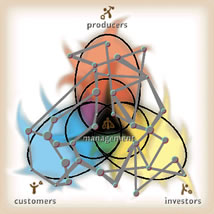 |
| The
ValueWeb Enterprise Model reveals the true operational scope of an enterprise both within and surrounding it with the many nodes and connections which function on multiple levels of recursion. These cannot be arbitrarily ignored with impunity. |
|
link
for reverences and examples |
| An Enterprise today - again, of any kind
- cannot be successfully managed only on its own
level of
recursion. It certainly cannot be transformed by
reference to a single layer of recursion or only
the iteration of the life cycle the enterprise
happens to be in at a given moment. The perspective is too narrow;
the necessary
levels of information and resources do not exist;
the required degrees of freedom (to think and act)
are not present. |
link
for reverences and examples |
| Few,
if any, enterprises today can deliver their product/service
successfully and be totally resource independent
within themselves - we have become a networked
society
where even
competitors have to, from time to time, collaborate.
Our organizational models do not reflect nor support
this reality. The ValueWeb architecture is a way
to address this deficiency. PatchWorks architecture
provides insight on how to most effectively “wire”
ValueWeb to work. |
link
for reverences and examples |
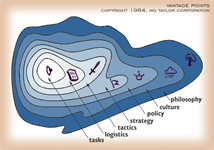 |
| The
Vantage Points Model conceived by Gilbert and modified my us show the various view points (and languages) from which an idea, product, objective must be addressed. |
|
link
for reverences and examples |
| Marcus
Aurelius, who was both an Roman Emperor and a Stoic
philosopher would understand the point that I am
making: all the vantage points have to
be addressed in any action related to enterprise
let along the transformational process. In fact,
they
are,
it
is just that the
majority of them, in abortive transformational attempts, are hidden assumptions and remain
unconsidered and not refreshed. Humanity, at large, it creating its future not by design but by default. The consequences
of this negligence
can be and are becoming increasingly more deadly. |
link
for reverences and examples |
|
| The
greatest impediment to a successful organizational
transformation program is the short term horizon
that presently dominates almost all institutional
and individual behaviors. There are no short cuts
to
either individual
or organizational transformation. There is no short cut in the road to making a viable global society either. There is no such thing as organizational transformation without the transformation of its individual members. This is true with the smallest organization to a planet. To attempt short
cuts is to corrupt the process. It is to ensure failure. More likely than not, it will leave the venture in far a worst condition than if nothing was attempted at all. |
link
for reverences and examples |
|
| I subtitled this paper “the hidden process” to emphasize some cardinal points about organizational transformation. Transformation is best not mentioned - it should not be the publicized purpose of the activities organized to accomplish this result. The activities should be promoted and aimed at more concrete objectives of the enterprise - they should be done in a way that promotes systemic change as consequences of accomplishing a series of carefully selected strategic objectives. A well done transformational process pays as it goes. This is what we were able to accomplish at AEDC [future link]. |
| Most of the actions which promote and support transformation are best when rendered indirectly. Except in extraordinary situations, confronting the system is rarely useful or necessary. In fact, the best way to “transform” an organization is for its management to recreate itself and to start being part of a new governance process that is consistent with a viable 21st Century venture. The transformation of an organization starts and ends with the individual. The primary role of the organization’s management is to support and protect the new initiative and to get out of the way other than to be part of it by doing their work in a new way. This is easily demonstrated on the level of a typical enterprise. I believe it will hold true with the larger ventures of humanity such as governance. The one difference may be this. With most ventures the idea that it is designed to have a purpose is well established. as I have noted, the idea of the HUMAN ENTERPRISE or of making a PLANET a work of art [future [link:] is so foreign to common thinking it cannot, it seems, be seriously considered. Yet, here we are at the threshold not only of these opportunities but also their dangers - we are transforming our world and ourselves by default, without much thought, serious social awareness and debate - let alone collaboration and design. In this circumstance, action has to be taken to both alert and to build capability which anticipates a time when these challenges will be addressed. The time from awareness to the necessity of action will be brief [future link:]. For certain, the transformation of human organizations will be required on all scales and the requirement to do so is growing while the capability to do it well greatly lags behind. |
| It is critical that the process of transformation does not cause the organization too become internally focused and obsessed - the focus must be kept on the mission of the enterprise and on always striving to accomplish this in the best way possible. This requires a leadership which can focus on two different, seemingly contradictory, yet critical and long term mutually supportive efforts: the mission and it work and delivery of products and services to a “market; and, the transformation of the organization (which may include it’s mission) to be viable in a better future. An organization cannot transform itself in a vacuum. The true task is to create a viable ValueWeb and become a fit member of it. Measures of an organization’s process towards a transformed state is the percentage of its effort that actually goes to creating real value and its ability to recreate and sustain itself, in variable conditions, over an extended span of time. People do not work for organizations - organizations work for people. Organizations augment people. They amplify individual effort. They are the armature necessary to sustain complex work. This is their only legitimate function. In the world of business, government and many social structures, today, we have this upside down. The old, angry, jealous, demanding, greedy and immature gods still rule. In this cycle, transformation starts with each individual and ends with a new planetary culture. Not a slavish and uniform culture. A variegated, robust, evolving new life form. This can - and must - be created on multiple levels of recursion: individual, team, group, organization, community, bio-economic region (which may replace the State), geopolitical systems, planet - and, soon, the solar system and beyond. This is immense complexity, yet, the pattern language of a viable living system is remarkably similar on each level of recursion. |
| This is the good news yet can be the bad - if we choose to act carelessly and allow negative patterns to replicate rapidity through multiple levels of recursion as we are increasingly seeing now - without employing feedback of a complex kind [future link:] and time for reflection and careful testing. If we do not get ahead of the change curve there will be no time for this. This is true for the re-making of a local business, a government in trouble, or a planetary society. We must design and build well. |
|
|
| Return
to: Matt Taylor Papers Index |
|
|
|
|
|
| GoTo:
Story of a Masthead |
|
|
|
|
Matt
Taylor
Boca Raton to Davos
January 22, 2005

SolutionBox
voice of this document:
VISION • STRATEGY • EVALUATE |
posted:
January 22, 2005
revised:
October 14, 2009
• 20050122.671999.mt • 20050621.455420.mt •
• 20050629.765209.mt • 20050713.779876.mt •
• 20050917.454511.mt • 20051005.500091.mt •
• 20051006.232300.mt • 20051009.220891.mt •
• 20060218.452300.mt • 20091014.271098.mt •
• 20091016.500125.mt • 20091017.889910.mt •
(note:
this document is about 85% finished)
Copyright© Matt
Taylor 2005, 2006, 2009 |
|